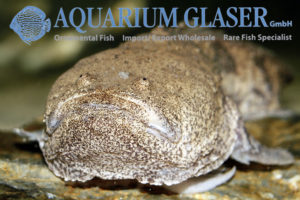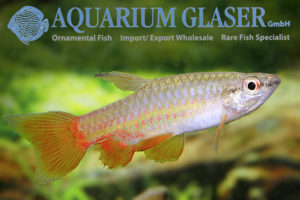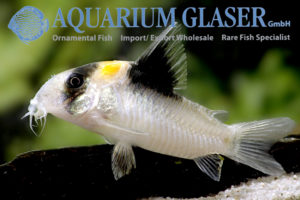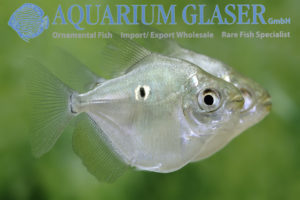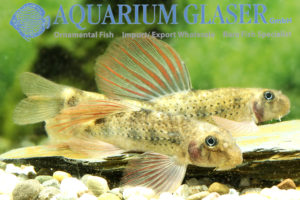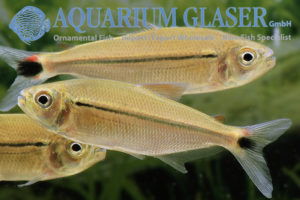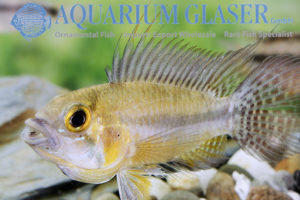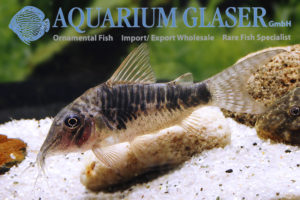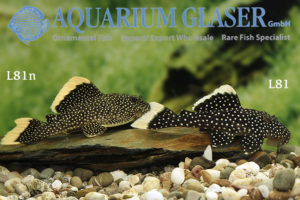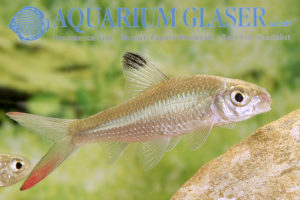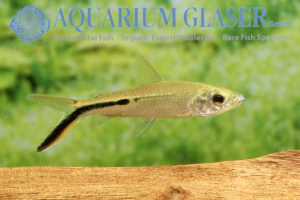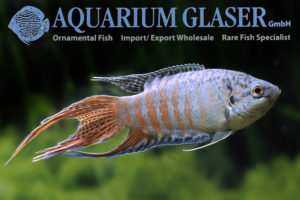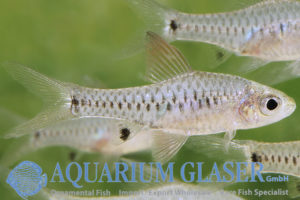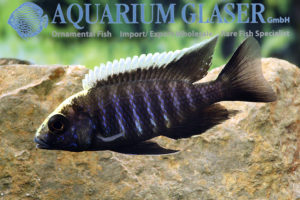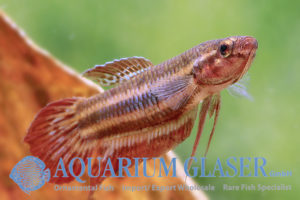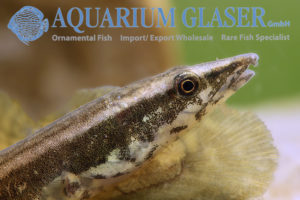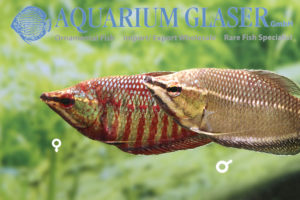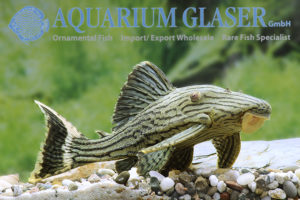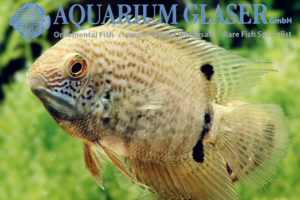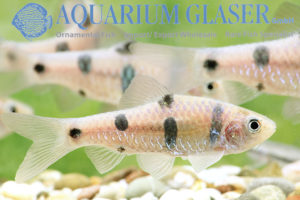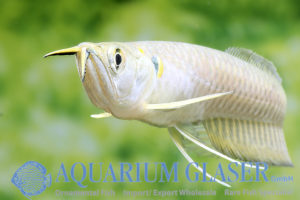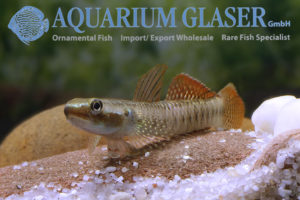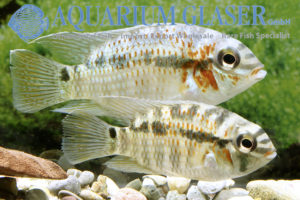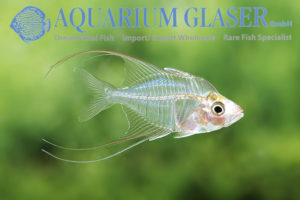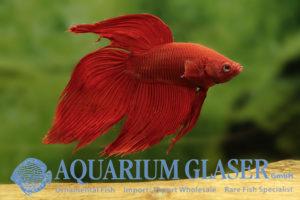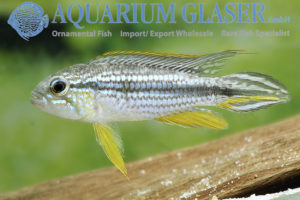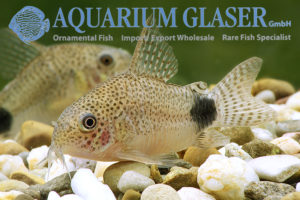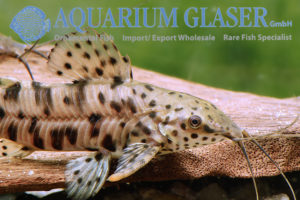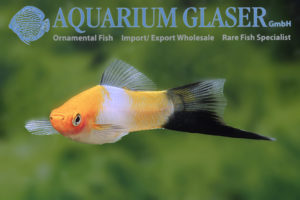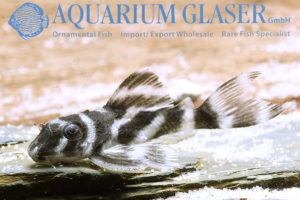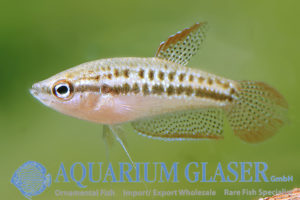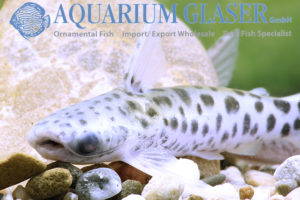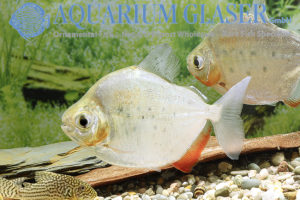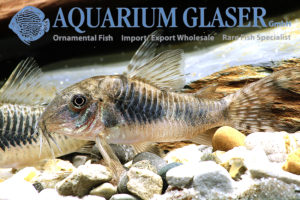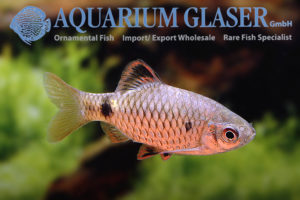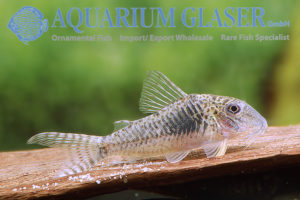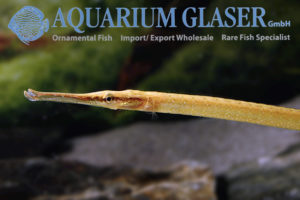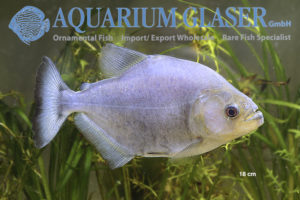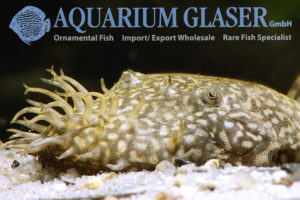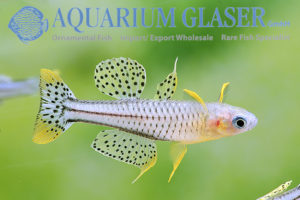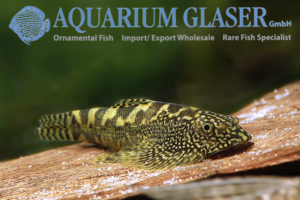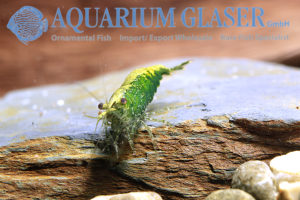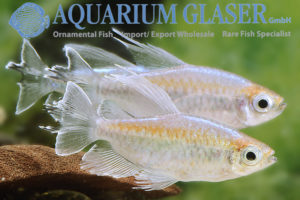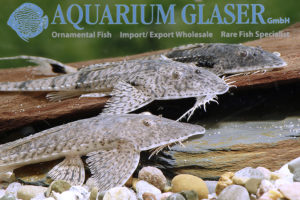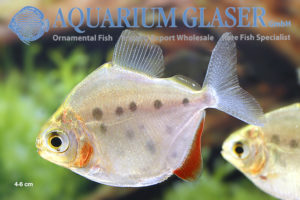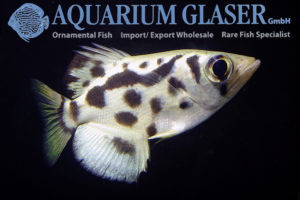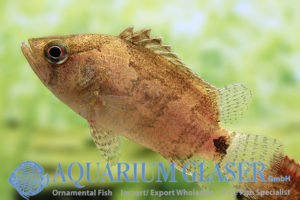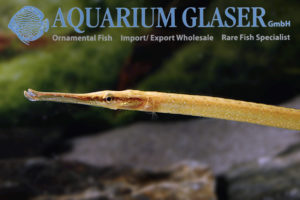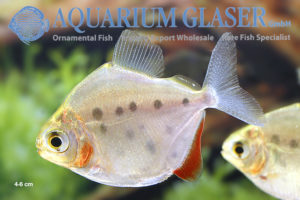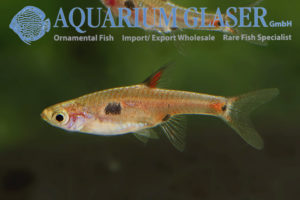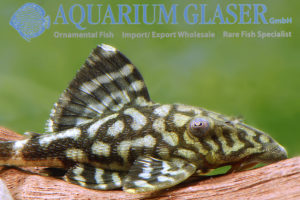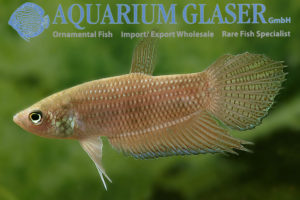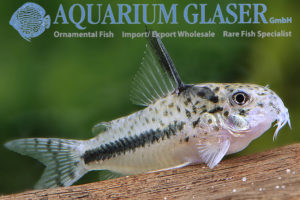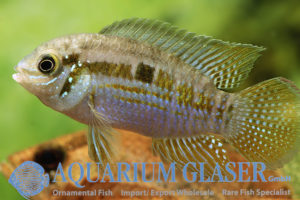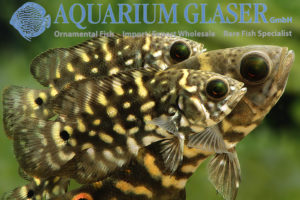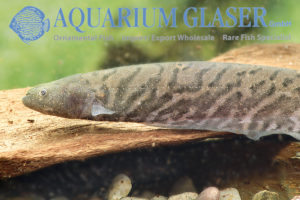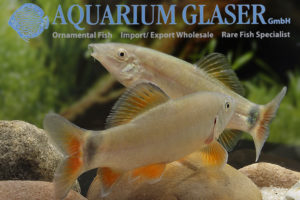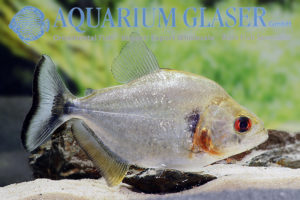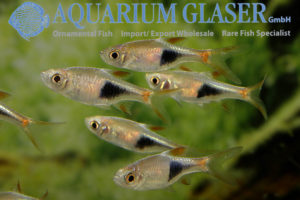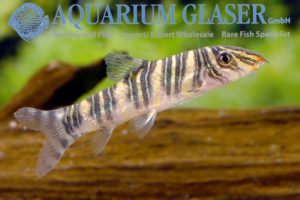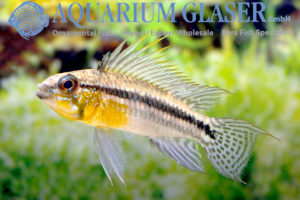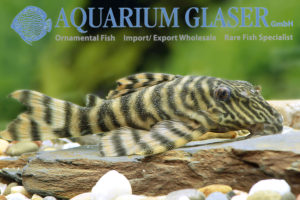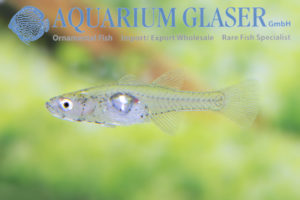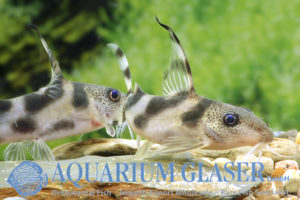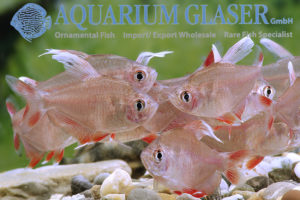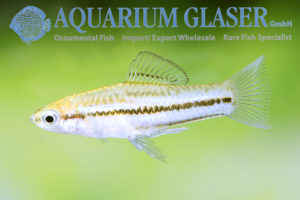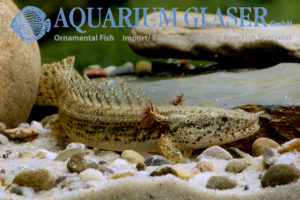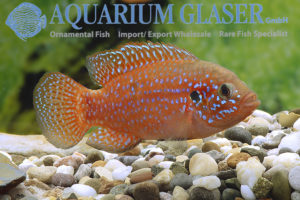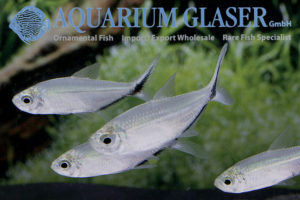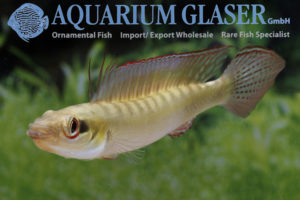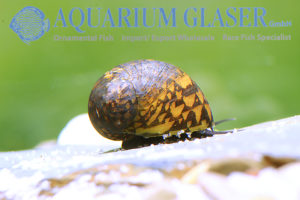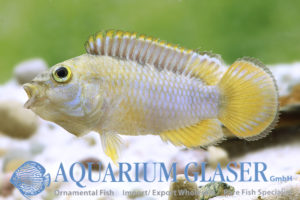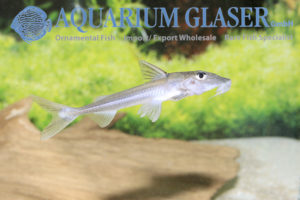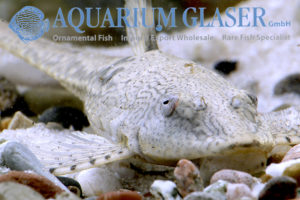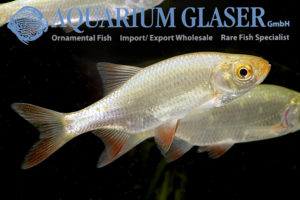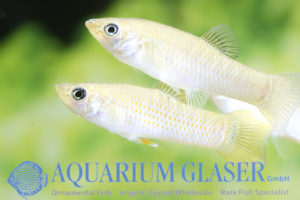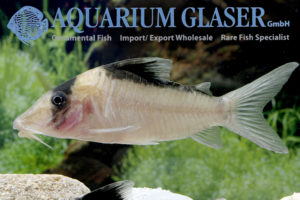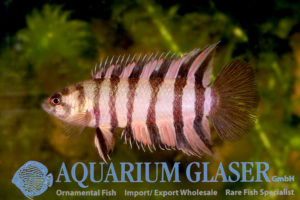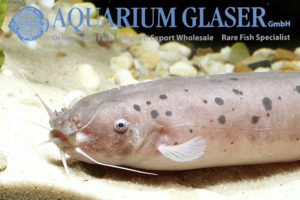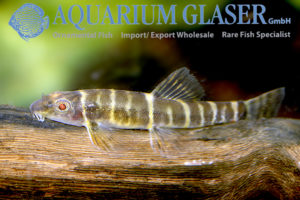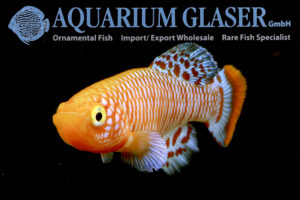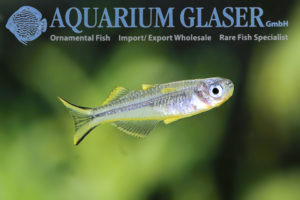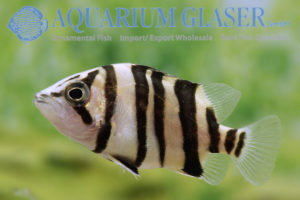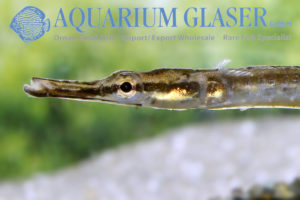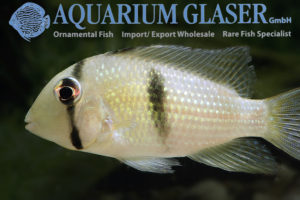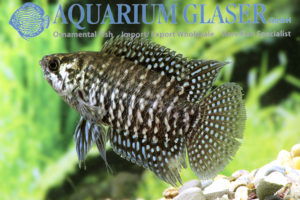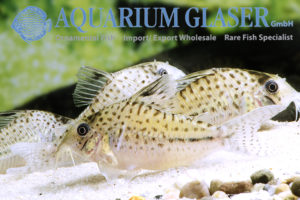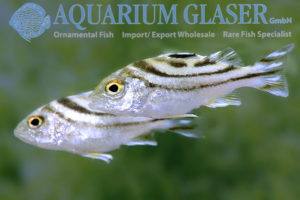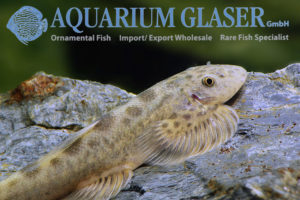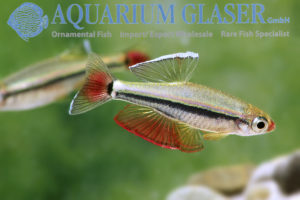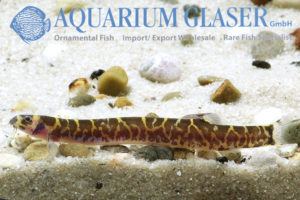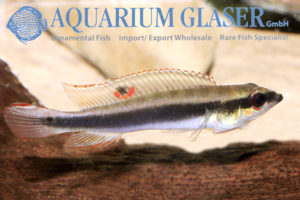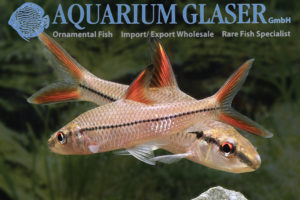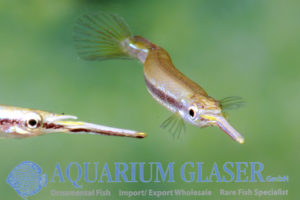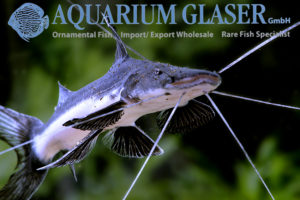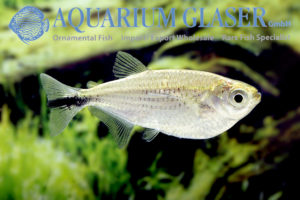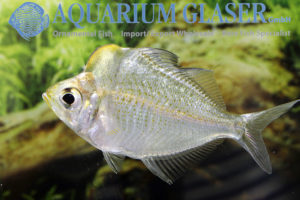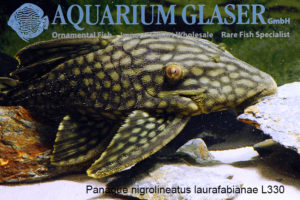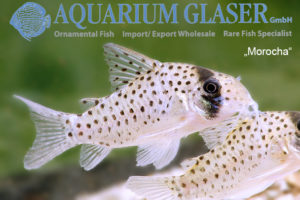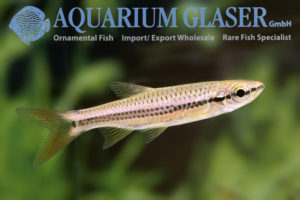The toadfishes a very odd creatures. A total of about 73 species exists which are placed in around 22 genera and three subfamilies. One of these subfamilies – the Thalassophryninae – is also known as the “venomous toadfishes”. Thalassophryne amazonica, one of the very few freshwater species of the family, is placed in that subfamily. […]
Fish Archive (3109)
-
-
Pyrrhulina brevis
The characins of the genus Pyrrhulina can be better compared to cichlids than to other characins in terms of their behavior. The males occupy small territories in the breeding season, color themselves splendidly and defend the spawn energetically until the young hatch. The generic name Pyrrhulina means “small bullfinch” because the males of many species […]
-
Corydoras burgessi
Now the season for the very beautiful and much beloved orange blotch corys has started. There does exist a good number of different species and varieties, all have in common a brightly shining spot on the neck. Depending on light this glows from yellow to almosr red. This glowing spot helps the fish in the […]
-
Mylossoma aureum
The magnificent pacus of the genus Mylossoma that reach at most approximately 30 cm of length (the average length in the nature amounts to approximately half of this measure), are only with difficulty determinable. The last revision from 2018 (Mateussi et al.) distinguishes 4 species south of the Andes (another species, M. acanthogaster, occurs in […]
-
Microphysogobio tafangensis
The genus Microphysogobio comprises more than 30 species of small (6-10 cm) gudgeons. Many species look very similar to each other and for many of them it became clear only by molecular examinations (DNA) that the comparatively small differences are in fact species differences. Aquaristically, these animals, which usually colonize fast-flowing, cool waters in nature, […]
-
Jupiaba sp. „Cherry Spot“
Once more we were able to import a new species of tetra from Venezuela which does not resemble to any species known to us. According to the supplier the animals were collected in small brooks in the surroundings of Puerto Inirida. There are no doubts that our new imports belong to the Astyanax relationship in […]
-
Apistogramma cacatuoides Yellow wild
The Cockatoo Dwarf Cichlid is one of the most popular members of the genus Apistogramma and found in petshops all over the World. Almost exclusively bred specimens of very colourful sports are traded. These do not appear in the wild. However, “the” wild form of A. cacatuoides does not exist at all. Like so many […]
-
Corydoras sp. Souza, C124
We received very nice, fully grown specimens of this only very rarely available species from Peru. This species of Corydoras is very variable in respect of the pattern. However, we think the darkest animals are the males. For our customers: the fish have code 225215 on our stocklist. Please note that we exclusively supply the […]
-
Baryancistrus xanthellus L18, L81, L81n, L177
About from the end of May to the end of September the season of the beautiful Golden Nuggets of the genus Baryancistrus lasts. Although the fish are considered to be extremely common in nature, are also found in shallow water and have been used as food fish since time immemorial, they were only scientifically described […]
-
Discherodontus ashmeadi
The redtail barb Discherodontus ashmeadi originates from the tropical Southeast Asia. It can reach an overall length of up to 14 cm. They occur widespread in the Mekong and Meklong areas. In their appearance especially the dark dorsal fin spot and the strong red markings of the caudal fin stand out. In their native country […]
-
Anodus orinocensis
From Venezuela we could import Anodus orinocensis for the first time. As a young fish A. orinocensis often lives in mixed shoals with Hemiodus gracilis. The two species really look amazingly similar, but Anodus is a Aufwuchs eater, and also filters the water for small organisms and swims mostly in “normal” horizontal swimming position, while […]
-
Macropodus opercularis “Blue“
There are no blue paradise fish in nature, they are a cultivated form with a blue back (vs. red-brown in the wild form). When exactly and in whom the first blue paradise fish appeared is not documented. It must have been in the late 1940s or early 1950s, because from then on they were mentioned […]
-
Oreichthys parvus
Unfortunately, Roloff’s Pygmy Barb – the popular name dates back to the 1950s and refers to the synonym Puntius roloffi – very rarely finds its way into our aquariums. The cute animal grows only about 3 cm long and its appearance is somewhat reminiscent of the Checkered barb, Oliotius oligolepis (formerly: Puntius o.). In contrast […]
-
Aulonocara maylandi
The sulphur head aulonocara, Aulonocara maylandi, is one of the most peaceful species of Malawi cichlids. The species reaches a maximum length of 12 cm (male) and 10 cm (female). In the wild these fish only live in two reefs of the south-eastern Lake Malawi, namely Chimwalani Reef (formerly Eccles Reef) and Luwala Reef (formerly […]
-
Betta coccina
Right now we have especially large and beautiful Betta coccina from Indonesia in stock. As the pictures show, this time the males have particularly extensive blue patches on their flanks; the females of Betta coccina generally do not have blue flank scales. Betta coccina can be kept well in groups, but even these comparatively peaceful […]
-
Sinobdella sinensis
For the first time we have obtained this highly interesting, small spiny eel. The species rarely grows larger than 20 cm and inhabits China and parts of Vietnam. According to its origin, care in unheated aquariums is recommended. In Sinobdella the dorsal, caudal and anal fins are fused together, in Asian spiny eels this is […]
-
Sphaerichthys vaillanti xxl
From Indonesia we have received extraordinarily beautiful and especially large Sphaerichthys vaillanti. According to our supplier they come from the vicinity of the Danau Senatrum National Park in the part of Borneo belonging to Indonesia called Kalimantan. For more information about this magnificent animal see https://www.aquariumglaser.de/en/fish-archives/sphaerichtys-vaillanti/ Text & photos: Frank Schäfer
-
Panaque cf. titan Shampupa L418
The magnificent panaques of the nigrolineatus complex have long been sought-after aquarium fish. All species seem to grow around 40 cm long. One of the most spectacular species comes from Peru and was given the L-number 418. It is probably identical with the described species Panaque titan, but since this is not completely certain, the […]
-
Heros sp. Manacapuru
Manacapuru is the third largest city in the state of Amazonas in Brazil. It is located about 80 km west of Manaus at the confluence of the Rio Manacapuru and the Amazon. A large, lake-like extension of the Rio Manacapuru near the city is called Lago Cabaliana. From the surroundings of Manacapuru, especially the red-backed […]
-
Barbodes dunckeri (= “Barbus everetti”)
The clown barb, Barbodes dunckeri, is a well-known and beautiful aquarium fish, but for decades it has been incorrectly called Barbus everetti, sometimes under the generic name Puntius, which is also incorrect for this species. The wrong name is based on a mix-up, the “real” Barbodes everetti is unfortunately almost never on the market (see […]
-
Osteoglossum bicirrhosum
One of the absolute classics among the large fish, which have been an indispensable part of the assortment of zoos, show aquariums and also private large aquariums for decades, is the silver arowana, Osteoglossum bicirrhosum, which is widespread in the Amazon region and the rivers Rupununi and Oyapock (Brazil, Colombia, Ecuador, Guyana, French Guyana and […]
-
Stiphodon ornatus
This beautiful freshwater goby was originally described as a subspecies of Stiphodon elegans. It originates from West Sumatra (Indonesia), where it lives in clear streams. Stiphodon ornatus feeds on an Aufwuchs, i.e. it feeds on algae and the small creatures that live in them. In the aquarium any form of dry, frost and live food […]
-
Krobia xinguensis
Only in 2012 this pretty cichlid was scientifically described, before that it was known in the hobby as Krobia sp. “Xingu Red Head”. As the name suggests, the animal originally comes from the Rio Xingu in Brazil. However, the species is only available as bred ones. This beautiful Aequidens relative is the ideal cichlid for […]
-
Gymnochanda flamea
A very wonderful dwarf glassfish reached us from Indonesia: Gymnochanda flamea, the red filamentous glassfish. All Gymnochanda species (G. filamentosa, G. flamea, G. limi, G.ploegi and G. verae) are pure freshwater fish, you should never add salt to the water. Only two species, G. flamea (South-Borneo) and G. filamentosa (Malaysia, Sumatra (?), West-Borneo) have thread-like […]
-
Betta splendens Veiltail
The history of becoming a domesticated animal is hardly researched for many species and is full of secrets, as it is with Betta splendens. There is some evidence that its true domestication only occurred after the collapse of the Khmer Empire in the 15th century. Before that, Betta splendens had been used for fish fights, […]
-
Apistogramma agassizii „Tefé“
There are many colour varieties of Apistigramma agassizii. The species – as it is currently understood – occurs in the complete Amazon river area in Colombia, Peru, and Brazil. The most wanted variety is probably the „Tefé“ variety. It is, however, not really proven that this variety really comes from the Rio Tefé, a right […]
-
Corydoras caudimaculatus Wild
From the Brazilian state of Mato Grosso, more precisely from the upper Rio Guaporé, comes the pretty Corydoras caudimaculatus, which reaches 5-6 cm in length. C. caudimaculatus is the most round-nosed and high-backed species of the “tail-spotted armored catfish”, which all have a similar pattern, but without being closely related to each other. The evolutionary […]
-
Megalechis thoracata
The Port Hoplo Megalechis thoracata – maybe the synonym (now invalid) name Hoplosternum thoracatum is more familar to some readers – is one of the earliest aquarium fish at all. The fish has only one real disadvantage: the maximum size, which is about 15 cm (or sometimes even larger). However, the species has a comparatively […]
-
Xiphophorus hellerii Wagtail Red White
The pretty swordtail breeding form Xiphophorus hellerii Wagtail Red White is still young, it was only created in our millennium. The animals are descendants of the red and white “Koi swordtails”, which by the way are mostly born red and in which the white areas only develop with increasing growth. These fish have less silvery […]
-
Hypancistrus sp. L500
In northern tributaries of the Amazon, namely the Rio Nhamunda (L475), the Rio Padauari (L499) and the Rio Uatumá (L500), there are very similar Hypancistrus, which have a relatively stocky body in common. In colour they resemble very much the Hypancistrus furunculus (L199) from the upper Orinoco. All four Hypancistrus are extremely variable in colour, […]
-
Trichopsis pumila
The Pygmy gourami, Trichopsis pumila, is one of the prettiest labyrinth fish. With a maximum length of 4 cm (usually it stays one centimeter smaller) it is a real dwarf fish. The species occurs in Thailand, Laos, Vietnam, and Cambodia. Although the species is an obligatory air breather, so would drown if you block its […]
-
Balroglanis schultzi (formerly Centromochlus s.)
The driftwood catfishes enjoy an increasing popularity, since it succeeds regularly to reproduce them. All species have – as far as known – an internal fertilization, the females spawn later without the presence of a male. Most driftwood catfishes are active at night or twilight. Many species are known to hunt land insects that have […]
-
Metynnis lippincottianus
Silver Dollars, which are the piranha relatives that eat mainly vegetable food, usually grow quite large, most species grow to over 20 cm, some to 40-60 cm long. The smallest known species is Metynnis lippincottianus, of which we can offer sexually mature specimens. They are currently 8-12 cm long, more than 15 cm total length […]
-
Corydoras aurofrenatus
For the first time, we have this beautiful Corydoras, that was described already 1903 from Paraguay, as bred ones in stock. However, there is no possibility to distinguish the Corydoras aurofrenatus from C. ellisae, which was also described from Paraguay in 1940. Therefore both species were synonymised by Axenrot and Kullander in 2003, the name […]
-
Pethia stoliczkanus (formerly Barbus s. or Puntius s.)
Stoliczka´s barb, Pethia stoliczkanus, originates from Burma and was a popular aquarium fish until the 1960s, as the up to 6 cm long animals are very temperature tolerant and do not require heating in the aquarium. Later it was displaced by more colourful species and today it is a rarity. The pictures show wild collected […]
-
Corydoras sp. “Peru”
Sometimes it is coincidence that determines whether a fish species can establish itself in the hobby. In the case of this Corydoras sp. Peru, a Corydoras fan noticed the fish when visiting a wholesaler; they were so-called by-catches that had been sorted out. Unfortunately, the wholesaler could not remember exactly where the animals originally came […]
-
Microphis brachyurus
The short-tailed freshwater pipefish (Microphis brachyurus) has been described from Indonesia. For a long time it was believed to be a species with a worldwide distribution, which differed only slightly at the subspecies level in the various distribution areas. And so M. lineatus (code 430104 on our stocklist) and M. aculeatus (code 149104) were considered […]
-
Serrasalmus immaculatus
In great parts of South America there are large (up to 50 cm) piranhas, which usually become black when they are old. Another common feature of these piranhas is a red iris. It is currently common practice to refer to all these animals as Serrasalmus rhombeus because they are indistinguishable as adult fish. However, young […]
-
Ancistrus claro
One of the smallest Ancistrus species is Ancistrus claro, which was known as LDA 8 before its scientific description. The catfish originates from clear water streams with a strong current in the upper part of the Rio Paraguay-Paraná river basin and becomes at most 6-8 cm long. The sexes are not quite as easy to […]
-
Pseudomugil gertrudae Aru II xl
The cute blue-eyes of the species Pseudomugil gertrudae are actually always in our stock. We usually get them as bred ones from Indonesia. Originally they are found in northern Australia and southern Papua New Guinea. At the moment we have fully grown, about 4 cm long animals in stock, which we received from a European […]
-
Sewellia “breviventralis”
From Vietnam we have once again been able to import beautiful hillstream loaches of the genus Sewellia under the name Sewellia breviventralis. The species S. breviventralis exists and it is anatomically very similar to the imported animals, but there are differences in colouring compared to the live imported animals, whose exact origin is unknown, but […]
-
Neocaridina davidi Jade Green
The “universal dwarf shrimp for all occasions” also comes in green: Neocaridina davidi Jade Green. Indeed, some of the animals shine quite unbelievably, the comparison with Jade is in this case no flowery exaggeration. In terms of care and breeding, the dwarf shrimps are no different from their different-coloured conspecifics. For our customers: the animals […]
-
Phenacogrammus interruptus
The Congo Tetra, Phenacogrammus interruptus, sometimes also called the Blue Congo Tetra, is the only one of the approximately 350 tetra species in Africa that is always available in pet shops. This is of course due to its beautiful colouring, which shimmers differently on the flanks depending on the incidence of light, the reddish-brown back, […]
-
Pseudohemiodon laticeps
Pseudohemiodon laticeps from Paraguay belongs to the longest known mouth-breeding Whiptail Catfish in the hobby, even if this large (up to 35 cm) species with its species-specific broad, triangular head was confused for a long time with the very similar, narrow-headed species P. platycephalus from Brazil. Mostly one sees both species in a fawn-brown colouring […]
-
Metynnis sp. Big Spots Peru
From Peru we occasionally receive beautiful young Metynnis. We have not yet been able to identify them; they either belong to a scientifically undescribed species or represent a local form of M. maculatus. They certainly belong to the species cluster around Metynnis maculatus and we think that the final size, similar to M. maculatus, is […]
-
Toxotes blythii
This archer fish that lives exclusively in freshwater originates from Burma. It has been discovered as early as 1860 and received its correct scientific name in 1892. Since then it has not been found anymore. Only in 2004 the first specimens appeared in the international trade and were celebrated as a sensation. These first specimens […]
-
Nandus nebulosus
Via Singapore we have once again received Nandus nebulosus in beautiful, fully grown specimens. The species can, like all other leaf fish, change its colouring very fast and drastically, furthermore each specimen has an individually different marble pattern. Some of our new arrivals have a head profile which is much more pointed than expected from […]
-
Microphis brachyurus
The short-tailed freshwater pipefish (Microphis brachyurus) has been described from Indonesia. For a long time it was believed to be a species with a worldwide distribution, which differed only slightly at the subspecies level in the various distribution areas. And so M. lineatus (code 430104 on our stocklist) and M. aculeatus (code 149104) were considered […]
-
Metynnis sp. Big Spots Peru
From Peru we occasionally receive beautiful young Metynnis. We have not yet been able to identify them; they either belong to a scientifically undescribed species or represent a local form of M. maculatus. They certainly belong to the species cluster around Metynnis maculatus and we think that the final size, similar to M. maculatus, is […]
-
Boraras maculatus
The Dwarf rasbora (Boraras maculatus, formerly known as Rasbora maculata) is the species of genus Boraras that is known for the longest time in the hobby. None of these species grows bigger than 2-3 cm and thus they are perfect candidates for the so-called nano-aquaria. All like to be kept in soft and acidic water, […]
-
Panaque schaeferi L203 L90c
Among the largest loricariid catfish are some of the wood-eating Panaque species. Panaque schaeferi is one of them, the species will certainly grow to about 60 cm long. Since P. schaeferi was described on the basis of adult specimens, the assignment to the young animals belonging to it has never been scientifically confirmed. However, it […]
-
Betta apollon
Betta apollon was scientifically in 2006 and comes from forest streams in the hilly country west of Narathiwat in Thailand. The mouthbrooding species belongs to the immediate relationship of Betta pugnax. The fish was named after the Greek god Apollon, who stands for beauty and elegance among other things – an aptly chosen name for […]
-
Corydoras sipaliwini
There are three beautiful, very closely related, small (4-5 cm) armored catfish species on the Guyana Shield in South America, which look so similar to each other that they have already been seen as synonymous with each other in the past: Corydoras bondi, C. coppenamensis and C. sipaliwini. However, most lovers of Corydoras share the […]
-
Laetacara araguaiae
Finally we were able to import once more this charming dwarf cichlid. The fish was known in the hobby under the name of Laetacara sp. “Buckelkopf” ( = humphead) before the scientific description. For more informations, please click https://www.aquariumglaser.de/en/fish-archives/laetacara_araguaiae_en/ For our customers: the animals have code 603002 on our stocklist. Please note that we exclusively […]
-
Astronotus cf. crassipinnis “Bumble Bee”
Currently we import very pretty young Oscars from Brazil, which are offered under the name “Astronotus crassipinnis”. The species A. crassipinnis exists in Brazil, but there is no possibility to check if the species identification is correct. We suspect that the animals are bred ones. The beautiful fish show the typical behaviour of all Astronotus […]
-
Gymnotus carapo
The number of scientifically described species in the genus Gymnotus increases rapidly recently. Since the last complete revision of the New World Knifefishes by Francisco Mago-Leccia in 1994 34 new species and 7 subspecies have been described, raising the total number of known species to 43. Members of the genus Gymnotus are cylindrical shaped and […]
-
Yasuhikotakia (formerly: Botia) eos
This beautiful and interesting loach, which can attain a maximum length of about 12 cm, originates from Thailand. This type of loach is said to be sometimes very aggressive. Y. eos is considered as one of the most aggressive species of all. However, in most cases this is a mistake of the keeper. Y. eos […]
-
Serrasalmus rhombeus „Tocantins“
From the Rio Tocantins in Brazil we received wonderful, 11-14 cm long Serrasalmus rhombeus. This species grows 35 cm, maybe even 50 cm long, making it one of the largest piranha species of all. One can recognize adolescent S. rhombeus quite well by the combination of ruby red eye, a shoulder spot which is not […]
-
Trigonostigma truncata
Genetic investigations have shown that there is not only one harlequin barb, but several similar forms, which still need to be scientifically investigated. We have been importing beautiful wild collected specimens from southern Thailand for several years. Their colouring differs significantly from “normal” harlequin barbs: a blue line above the wedge, an orange spot […]
-
Botia striata
Currently we have very nice zebra loaches, Botia striata, in stock. The animals have an ideal size, 3-4 cm. The maximum length the species can reach is about 6-8 cm. In many species of loach the generic name has changed in the past years. The Clown loach, formerly known as Botia macracanthus, is now Chromobotia […]
-
Apistogramma bitaenata Brazil
Apistogramma bitaenata is one of the most beautiful species of the genus. And it is known for a very long time in the hobby already. Elder hobbyists will know the species maybe under the name of A. kleei, other, well known synonymys are A. klausewitzi and A. sweglesi. The species has a very wide distribution […]
-
Panaqolus sp. L2
The tiger pleco was already imported and presented in 1988; since then, unfortunately, no scientist has yet taken a closer look on the beautiful animals imported from Rio Tocantins in Brazil for the hobby; therefore, this relatively small, maximum 12 cm long, peaceful loricariid catfish still has no “correct” name, but has to be content […]
-
Gobiopterus chuno
The glass goby, Gobiopterus chuno, is a fascinating small fish (2-3 cm), which was originally described from the estuaries of the Ganges. Now we have received glass gobies from Thailand under the name G. chuno; they look slightly different from those we know from India (see https://www.aquariumglaser.de/en/fish-archives/gobiopterus_chuno_en/); it may be G. brachypterus, a species originally […]
-
Synodontis decorus
One of the most beautiful squeaker catfish (Synodontis) comes from the Congo: Synodontis decorus. The slender species grows about 20-30 cm long and is relatively peaceful. One must always consider that all squeaker catfish have a hierarchy among each other, where “social biting” is absolutely necessary and not alarming, since it only comes to superficial, […]
-
Hyphessobrycon “ornatus White Fin” XL
We just have a tank full of fully grown rosy tetra (Hyphessobrycon rosaceus) of the breeding form “White Fin” in stock. These magnificent fish are a real feast for the eyes. Read more about this form of fish, which is also known as H. bentosi or H. ornatus in the hobby here: https://www.aquariumglaser.de/en/fish-archives/hyphessobrycon-ornatus-white-fin-2/ For our […]
-
Xiphophorus continens
For the first time ever we can offer this dwarf swordtail rarity. Our animals are German offsprings. At first sight the small, only 2-3 cm long animals remind of the also dwarf X. pygmaeus, but they are not so closely related to this species. Only in 1990 X. continens was formally described, first collected in […]
-
Polypterus ansorgii
Polypterus ansorgii is perhaps the rarest of the bichirs and also comes from regions in Africa from which ornamental fish exports are rarely possible for political reasons. We have already occasionally reported on this interesting, large-growing species (https://www.aquariumglaser.de/en/fish-archives/polypterus-ansorgii/ and https://www.aquariumglaser.de/en/fish-archives/polypterus_ansorgii_xxl_en/) and a detailed report on P. ansorgii can be found here: https://www.aqualog.de/blog/ansorges-floesselhecht-ein-mythos-wird-entschleiert/ (sadly in German […]
-
Hemichromis guttatus “Paprika”
Right now we have German offspring of Red Jewel Cichlids – probably Hemichromis guttatus – in stock, which have a very interesting history. They are descendants of wild catches from Hungary! In Hungary, more precisely in the Hévíz region, there is a thermal lake fed by natural hot springs. It is not known by whom […]
-
Moenkhausia costae
This tetra originates from Brazil (Rio Sao Francisco and Itapicuru). It reaches a maximum length of about 7 cm. Currently we can offer German bred specimens of this attractive schooling fish. For our customers: the fish have code 268613 on our stocklist. Please note that we exclusively supply the wholesale trade. Text & photos: Frank […]
-
Crenicichla notophthalmus
The genus Crenicichla is with about 100 species one of the most species-rich cichlid genera at all, and yet there are numerous forms that, if we see them alive, do not really want to fit the described species. On the other hand, there are also described species of which we already doubted about their existence, […]
-
Neritodryas cornea
From Thailand we have received pretty snails under the name Neritina coromandeliana. Whether such names are correct, we usually cannot decide, as we have only ichthyologists (= biologists specialized in fish) in our team. Many German snail experts believe that these animals, which are characterized by their zigzag pattern and yellow triangles on a dark […]
-
Apistogramma nijsseni
The Panda Dwarf Cichlid (Apistogramma nijsseni) was an absolute sensation when it was first introduced at the end of the 1970s. The breeding was successful right away, but it took several years before it was understood that the – often extreme – male surplus observed in the offspring came from too high water temperatures during […]
-
Leptodoras cf. cataniai “Rio Nanay“
We receive only very rarely imports of one of the unusual and stress-prone Leptodoras species. These thorny catfish are extraordinarily elongated and apparently live in flowing waters, while many other thorny catfish – think of the Platydoras, Agamyxis etc. which are common in the hobby – are more at home in dead wood or leaves […]
-
Sturisomatichthys leightoni
Until recently, two genera of closely related whiptail catfish were distinguished according to anatomical features: the relatively short-nosed Sturisomatichthys with four described species and the relatively long-nosed Sturisoma with over 15 species. All species are popular aquarium fish because they are attractive and easy to breed. Unlike most other loricariid catfish they do not breed […]
-
Scardinius erythrophthalmus – the rudd
The corona crisis has delayed the start of the pond fish/cold water season, but now we have at least a few native biotope fish in stock. The name “biotope fish” should not hide the fact that these are bred fish, which are intended for aquarium and garden pond keeping and must not be released into […]
-
Poecilia sp. Central America
Right now we can offer a very special delicacy for the friends of livebearers: a scientifically still undescribed wild molly! It is a F1 offspring of a wild collected species from the Poecilia sphenops relationship. The parent animals were collected on a scientific expedition. The description of the species is in progress, so we have […]
-
Corydoras cf. imitator C140 Red Spot
Again and again we receive imports of Corydoras from the upper Rio Negro area, which differ in details from the well known Corydoras adolfoi, C. duplicareus, C. imitator, C. serratus & Co. It is difficult to classify them in such cases. Are these only colour variations that occur in large numbers somewhere? Are they geographically […]
-
Microctenopoma ansorgii
We have very nice and stable wild catches of the Orange Bushfish from the Congo in our stock. The bubblenest-building species grows to about 6-8 cm, currently the animals are 3-4 cm long. The Orange Bushfish is a very interesting species. It becomes already half grown and sexually mature. With increasing age the fish becomes […]
-
Malapterurus beninensis – Electric catfish
For a long time it was believed that there were only two species of electric catfish, namely the widespread Malapterurus electricus and the Congolese M. microstoma. Then two independent revisions of the genus appeared practically at the same time, one by Roberts (2000) and one by Norris (2002), which drastically increased the number of species, […]
-
Barbucca diabolica
Currently we managed once more to import one of the cutest loaches from Borneo. Barbucca diabolica is despite its terrifying name a totally peaceful animal. Sadly almost nothing is known about the species. In nature, it lives in small forest streams in the Kapuas system on Borneo. Our animals have already almost the size of […]
-
Nothobranchius rachovii
Rachow´s Nothobranch (the species has been named to honour Arthur Rachow, thus the common name must end on a “w”), also called the bluefin notho, belongs not only to the longest-serving, but also to the timeless most beautiful species of killifish at all in our aquaria. Most often the orange colour morph is kept, which […]
-
Pseudomugil furcatus (formerly Popondetta furcata)
The blue-eyes Pseudomugil furcatus, relatives of the rainbow fish, originate from the island of New Guinea. However, there are never wild catches of the maximum 6 cm long, peaceful schooling fish on the market, but only offspring, all of which go back to a single collection in 1981. Since then they have been bred continuously. […]
-
Datnioides microlepis
The Indonesian Tiger Fish (Datnioides microlepis) is without any doubt the most beautiful species of Tiger Perch. These large growing predators can reach a maximum length around 50 cm and are wonderful show fish for large aquaria. But the photographed fish are still young, 4-6 cm long. There are two populations of this perch, one […]
-
Doryichthys martensii
The up to 15 cm long becoming freshwater pipefish Doryichthys martensii is widespread in southeast Asia, one knows it from Indonesia, Malaysia and Thailand. In nature, it is mainly found in flowing waters (streams, small rivers), where the animals can be found in the undergrowth of riparian vegetation. As with all pipefish, the male takes […]
-
Guianacara dacrya
The genus Guianacara currently comprises seven described species, all of which originate from the Guiana shield in South America. The genus was only established in 1989 and only one species – G. geayi – was known before; Pellegrin described it in 1909. From this one can already conclude that the species look quite similar. Before […]
-
Microctenopoma fasciolatum
Within the African labyrinth fishes, the so-called bushfishes, one can roughly differentiate between two groups: those that do not care for their brood and those in which the males build a foam or bubble nest, into which they are spawned and which is guarded by the male until the young fish are independent. The latter […]
-
Corydoras orphnopterus
216 scientifically described Corydoras species, of which 163 are generally accepted as valid (this number is, of course, constantly changing, as of March 2020), 159 C-numbers and 160 CW-numbers: one should think that gradually all Corydoras are sufficiently known. But there are still several species which are known only because of their scientific description and […]
-
Terapon jarbua
This brackish water fish – adult Terapon jarbua usually live in the sea, juveniles in brackish water, but the species is euryhalin and can be found both in the sea and in freshwater – is widespread along the coasts of South East Asia to Australia and East Africa. From the Red Sea, T. jarbua has […]
-
Hemimyzon nanensis
With the import of Hemimyzon nanensis we were once again able to fill a white spot on the map of fishes that have become known in the aquarium with content. At least for us it is a first import. Hemimyzon belongs to the family of hillstream loaches (Balitoridae) and is closely related to the genus […]
-
Tanichthys micagemmae – Jewel minnow
Currently three species of the genus Tanichthys are known in the hobby: the White Cloud Mountain minnow Tanichthys albonubes, the Jewel Minnow, T. micagemmae, and T. kuehnei, which was termed T. sp. „Vietnam“ prior to its scientific description. The White Cloud is available exclusively as bred specimens, wheras the Jewel minnow is also imported as […]
-
Pangio alternans
Kuhlii loaches (Pangio) are very popular aquarium fish. They are cute, small and often colourful. In community aquariums the small water snakes act as a cleaning crew, which reliably prevents food residues from being left lying around. The animals are completely peaceful and love the company of conspecifics. Kuhlii loaches become restless before thunderstorms and […]
-
Crenicichla sp. “regani-Orinoco”
The pike cichlids (Crenicichla) are one of the most species-rich cichlid genera with 94 valid species at present. Many species grow to well over 20 cm in length and thus belong to the large cichlids, but there are also dwarf cichlids. The latter include the beautiful, slender C. regani, which according to literature should grow […]
-
Cyclocheilichthys janthochir
Once more we have this beautiful species of shark in stock. Of course it belongs to the barb family, but species of several barb genera that have a similar body shape, are commonly called “shark” in the hobby. In our fishhouse it got the nickname “top-model-barb”, for it is very pretty, but looks also a […]
-
Hemirhamphodon tengah
This pretty little fish is a challenge for experienced hobbyists. The species originates from Borneo. In contrast to the widespread prejudice halfbeaks of the genus Hemirhamphodon do not appear in brackish water; they are strictly bound to very soft and acidic water! These fishes are commonly found along with chocolate gouramis and small rasboras. The […]
-
Brachyplatystoma platynemum
From Peru we have received some specimens of this very rarely imported catfish. The animals are in top condition and currently 10 – 12 cm long. Brachyplatystoma platynemum used to be placed in a separate genus, Goslinia, which is now a synonym for Brachyplatystoma. B. platynemum is distributed throughout the Amazon and Orinoco region and […]
-
Triportheus cf. nematurus
The unusual genus Triportheus contains very interesting, somewhat larger species. Depending on the species these fish attain a length of 15-25 cm. Currently 16 species are distinguished that inhabit all major river systems of South America. From time to time we import members of the genus from Paraguay. Two species can be found there, namely […]
-
Parambassis pulcinella
Once more we were able to import the most peculiar species of glass perch: Parambassis pulcinella. This freshwater fish originates from clear streams in the border region between Thailand and Burma. The maximum size reported so far is about 10 cm. Against conspecifics the species is rather peaceful. They tend to tease each other sometimes […]
-
L330 scientifically described: Panaque nigrolineatus laurafabianae
Many fish scientists (ichthyologists) currently reject the concept of the subspecies. They argue that either there are definable characteristics, in which case it is a species, or there are no characteristics, in which case the form cannot be named. However, this concept has only limited relevance to reality; in the case of the large striped […]
-
Corydoras cf. atropersonatus “Morocha“
For the first time ever we have received a very attractive Corydoras (called „Moriocha“) from Peru (unfortunately not more details), which looks very similar to Corydoras atropersonatus (this species also comes from Peru – Rio Nanay basin – and we have received this at the same time), but is even more attractive. Corydoras atropersonatus has […]
-
Rasbora cephalotaenia
One of the unfortunately very rare black water rasboras on offer is Rasbora cephalotaenia. The species is quite widespread on the Malay Peninsula to southern Thailand and on the large Sunda Islands (Borneo, Sumatra), presumably it is also found on smaller islands of the Sunda archipelago in suitable habitats. However, as peat swamps are drained […]
- « Previous Page
- 1
- …
- 9
- 10
- 11
- 12
- 13
- …
- 32
- Next Page »





